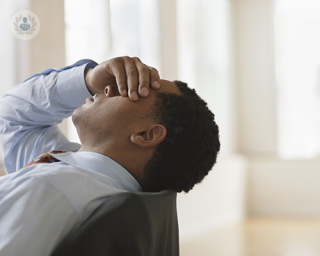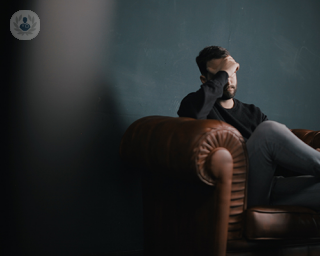Migraine
Dr Stephen Humble - Pain medicine
Created on: 02-05-2013
Updated on: 10-13-2023
Edited by: Sophie Kennedy
What is a migraine?
A migraine is a type of headache which occurs due to a chronic nervous system disorder. It is a debilitating headache which normally comes with other symptoms, such as nausea or photophobia (light sensitivity).

It is estimated that around 1 in 7 people are affected by migraines globally. Migraines tend to affect women more than men, so it’s thought that they may be hormonally driven.
There are two different types of migraine:
- Migraine without aura: these are the most common. It is much like a severe headache with some additional symptoms such as noise sensitivity.
- Migraine with aura: this is often more complicated as the patient tends to have neurological symptoms or visual alterations with the headache.
Prognosis of migraines
Migraine duration varies from patient to patient, so treatment will often vary. Some migraines don’t require treatment, but others do require pharmaceutical treatment and in some cases, even hospitalisation.
It’s important to see a specialist as this migraines can be linked to strokes. The risk increases in patients who take contraceptive pills or who do not have a balanced diet (which could cause high levels of cholesterol or hypertension). The risk is also higher in smokers, especially for women who have migraines with aura.
What are the symptoms?
There isn’t a specific test to diagnose migraines, but there are several symptoms that help identify them. These symptoms are classified according to the type of migraine.
A migraine with aura is often accompanied by nervous system symptoms (neurological) which warn of a potential migraine. These symptoms often start between 10 and 20 minutes before the headache starts. In many cases they affect vision in the following way:
- Temporary blind spot
- Eye pain
- Changes in vision with flashing lights or lines
- Blurry vision
- Only being able to see things that are close (tunnel vision).
These symptoms may also be accompanied by:
- Nausea or dizziness
- Weakness
- Yawning
- Difficulty concentrating
- Numbness
- Tingling.
The headaches tend to get worse as the day goes on. It tends to be a throbbing pain. In some cases it may only affect one side of the head, behind the eye, or in the neck, and it may last for up to 48 hours.
Migraines may come on alongside other symptoms such as; chills, urinating more frequently, fatigue, nausea, vomiting, sweating, photophobia, or sensitivity to light, among others.
What causes migraines?
The cause of migraines is not fully understood, but it is known that they happen due to abnormal brain activity. This may happen for many reasons, for example:
- Lack of caffeine
- Skipping a meal
- Smoking or cigarette smoke
- Drinking alcohol
- Environmental factors
- Stress or anxiety
- Loud noises or bright lights
- Changes in menstrual cycle hormone levels
- Lack of sleep or sleeping too much
- Some foods: chocolate, fruits (avocado, banana, and others), onions, processed foods, dairy products, and meat with nitrates among others.
Migraines can also be hereditary.
How can migraines be prevented?
The most important step in being able to prevent migraines is to find out what triggers them with the help of a specialist. Once the reasons are known, it is easier to avoid triggers and also follow some general guidelines:
- Get enough sleep
- Exercise regularly
- Slowly reduce caffeine consumption
- Control and learn to cope with stress
What are the available treatment options?
Treatment could help stop symptoms and prevent new migraine attacks. These may vary according to the intensity of the headaches, how often they happen, and how much they affect the person’s ability to perform daily tasks.
Even though there isn’t a specific cure, there are many medications that can help alleviate pain, some of the medications are more commonly used for other issues. They can be grouped in two groups:
- Painkillers: used to lessen the pain and symptoms when a migraine attack happens
- Preventive drugs: taken regularly to try to reduce the severity or frequency of attacks
Certain lifestyle changes can also help patients have fewer migraines or even avoid them altogether:
- Sleep the necessary hours and have a set sleep schedule
- Improve nutrition: avoid foods that trigger migraines and don’t skip meals
- Manage stress and anxiety
- If overweight, lose weight.
















